Breaking news
PACIFIC 2015: Pictures of the Contenders for the Australian Navy SEA5000 ASW Frigate Program.
| 2015
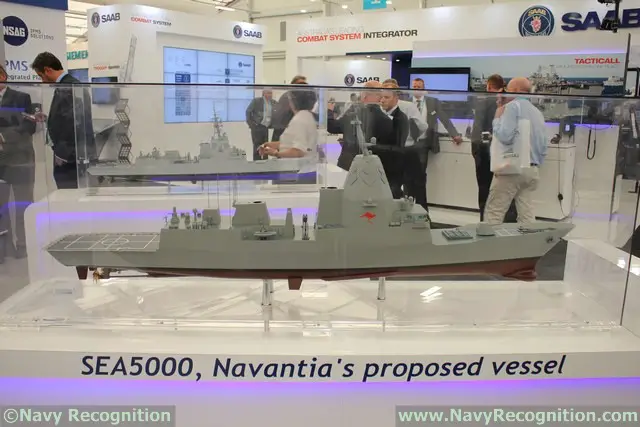 Navantia's
SEA5000 proposal is based on the Hobart class Air Warfare Destroyer design Navantia's
SEA5000 proposal is based on the Hobart class Air Warfare Destroyer design |
|||
Navantia
of Spain was the only one who showcased an actual scale model of its SEA5000
proposal. The vessel relies heavily on the Hobart class AWD design already
selected by the RAN. A Navantia official explained there is "up to
70% commonality between the two platforms from a production stand point".
The vessel would be fitted with 48x MK41 VLS cells, a SAAB combat management
system and 2 helicopter hangars. Navantia SEA5000 proposal basic specifications: Original design: RAN Hobart class ASW Length overall: 147.2 m Max beam: 18.6 m End of life displacement: 7400 t Accommodation: 237 |
|||
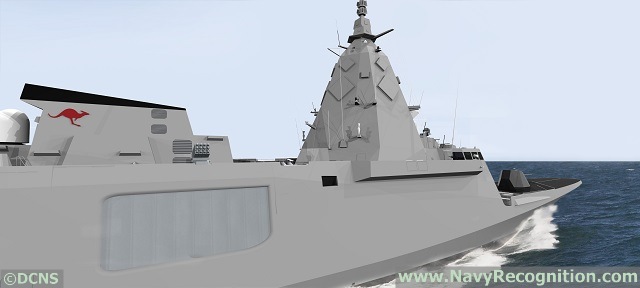 DCNS
SEA5000 proposal is based on the successful FREMM design DCNS
SEA5000 proposal is based on the successful FREMM design |
|||
DCNS
representative explained to Navy Recognition that the vessel
shares the same hull (same engines, same displacement) based on the proven
FREMM design. DCNS used its research and development work already conducted
on the FREMM ER (unveiled at Euronaval 2012) to fine tune the design of
the mast area for this SEA5000 proposal. As can be seen on the CGIs, the
FREMM for Australia is fitted with a 127mm main gun and a Rheinmetall
Millenium CIWS gun on top of the helicopter hangar. DCNS stresses that
this is "a first approach to SEA5000 with known or anticipated requirements"
and that it will adapt the design and systems fit as customer requirements
emmerge. The FREMM was designed from the start by DCNS as a potent ASW
platform with very low accoustic signature even at speed. DCNS SEA5000 proposal basic specifications: Original design: ASW FREMM (Aquitaine class) Length: 142 m Max beam: 20 m Displacement: 6000 t Accommodation: 145 to 180 |
|||
![During an industry meeting at PACIFIC 2015, Fincantieri unveiled the design of its proposal for the SEA5000 Future Frigate program. Based on the Italian Navy FREMM ASW (Virginio Fasan class), Fincantieri says it recently conducted feasibility studies to proof the possibility to use its FREMM platform to cope with different Navy requirements (including Canada and Australia). The Italian FREMM "can easily accommodate the CEAFAR2 [ed. note Fincantieri presentation mentionned the CEA PAR system]; weigh, CVG, electrical power consumption and fluidic requirements are aligned with the platform capabilities, without the necessity of major modifications". Finally, Fincantieri says it can easily install the SAAB CMS on board.](/images/stories/oceania/australia/exhibition/pacific2015/news/SEA5000_CEAFAR2_CEA_Radar_Fincantieri_FREMM_PACIFIC_2015.jpg) Fincantieri
SEA5000 proposal is based on the Italian Navy FREMM ASW design Fincantieri
SEA5000 proposal is based on the Italian Navy FREMM ASW design |
|||
During
an industry meeting at PACIFIC 2015, Fincantieri unveiled the design of
its proposal for the SEA5000 Future Frigate program. Based on the Italian
Navy FREMM ASW (Virginio Fasan class), Fincantieri says it recently conducted
feasibility studies to proof the possibility to use its FREMM platform
to cope with different Navy requirements (including Canada and Australia).
The Italian FREMM "can easily accommodate the CEAFAR2 [ed.
note Fincantieri presentation mentionned the CEA PAR system]; weigh,
CVG, electrical power consumption and fluidic requirements are aligned
with the platform capabilities, without the necessity of major modifications".
Finally, Fincantieri says it can easily install the SAAB CMS on board. Fincantieri SEA5000 proposal basic specifications: Original design: ASW FREMM (Virginio Fasan class) Length: 144 m Max beam: 19.4 m Displacement: 6,700 t Accommodation: 167 (up to 200 for RAN) |
|||
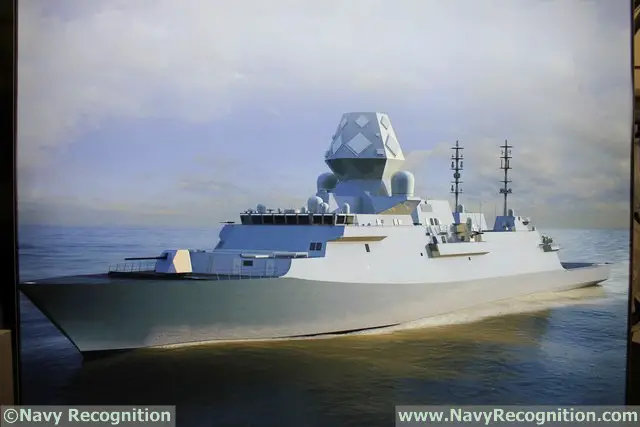 BAE
Systems SEA5000 proposal is based on the future Royal Navy Type 26 design BAE
Systems SEA5000 proposal is based on the future Royal Navy Type 26 design |
|||
The
Type 26 is the future Anti-Submarine Warfare Frigate that will replace
the Royal Navy's 13 Type 23 frigates and other ships. BAE Systems says
the Type 26 / Global Combat Ship will be a highly capable and versatile
multi-mission warship designed to support anti-submarine warfare, air
defence and general purpose operations anywhere on the world’s oceans.
Navy Recognition could not meet a BAE representative who could talk about
the SEA5000 GCS but we understand that it would be fitted with Mk41 cells
exclusively (no CAMM which are present on the UK design) as well as a
BAE Systems Mk 45 5 inch main gun. BAE Systems SEA5000 proposal basic specifications: Original design: Global Combat Ship (Royal Navy Type 26) Length: 148.5 m Max beam: 20 m Displacement: 6,000 t Accommodation: 118 crew + 72 embarked forces |
|||
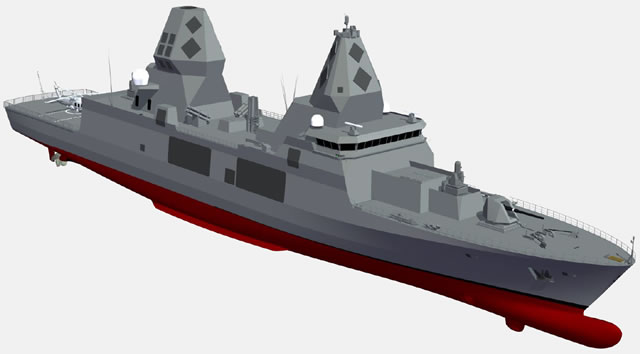 TKMS
SEA5000 proposal is based on the future German Navy F-125 design. Image:
TKMS TKMS
SEA5000 proposal is based on the future German Navy F-125 design. Image:
TKMS |
|||
TKMS
representatives explained to Navy Recognition at the show that
their SEA5000 proposal shares the same hull and machinery as the F-125
Frigate which matches the basic requirements. With its CODLOG propulsion
system, the vessel can reach up to 20 knots on electric propulsion (and
keep a very low accoustic level). F-125 can accomodate up to 64x VLS cells.
The proposal for the RAN has 32x cells forward and 16x more between the
two masts. Based on CGI, the SEA5000 configuration includes an Oto Melara
127mm main gun, two Phalanx CIWS (forward and aft) and two hangars. At
7,200 tons the F-125 is large ship, which is TKMS says is necessary for
the South Pacific Ocean. TKMS SEA5000 proposal basic specifications: Original design: F-125 (Baden-Württemberg class) Length: 149.5 m Max beam: 18.8 m Displacement: 7,200 t Accommodation: 110 (up to 190) |
|||
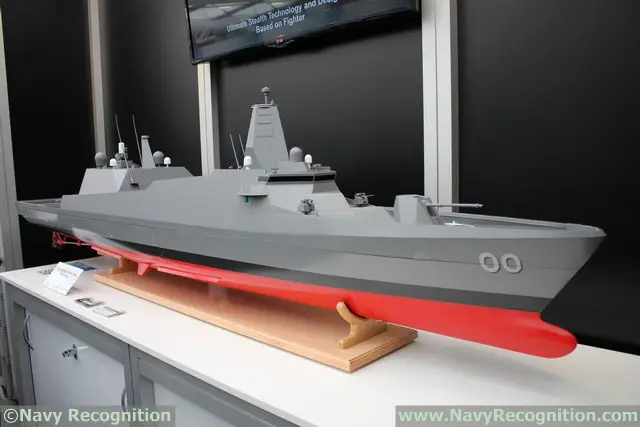 Mitsubishi
Heavy Industries SEA5000 proposal is based on the 30DEX project Mitsubishi
Heavy Industries SEA5000 proposal is based on the 30DEX project |
|||
Japan
Mod and MHI representatives told Navy Recognition at the show
that the 30DEX (sometimes called 30DX or FFX) is a new concept that was
shown in the mid-term defense buildup plan of Japan. The 30DX incorporates
lessons learned on stealth and radar technology when MHI developped the
ATD-X Shinshin stealth fighter experimental aircraft. Partners in the
30DX program include NEC, Fujitsu and Mitsubishi Electronics especially
for the integrated mast and radars. The model on display at PACIFIC 2015
is an actual remote controlled model use to test the ballance of the hull
in a test facility of the JMSDF. It features a Mk 45 main gun, 2x Marlin
- WS by Oto Melera (forward) and a SeaRAM on top of the helicopter hangar.
The hull is fitted with two shafts and two water jets to answer the high
speed requirement of the JMSDF: 30DEX is required to reach 40 knots. For
SEA5000 MHI is ready to integrate CEA's CEAFAR2 radar on 30DEX. MHI SEA5000 proposal basic specifications: Original design: 30DEX (MHI projet for JMSDF) Length: 120 m Max beam: 18 m Displacement: About 3,000 t Accommodation: About 100 |
|||



























